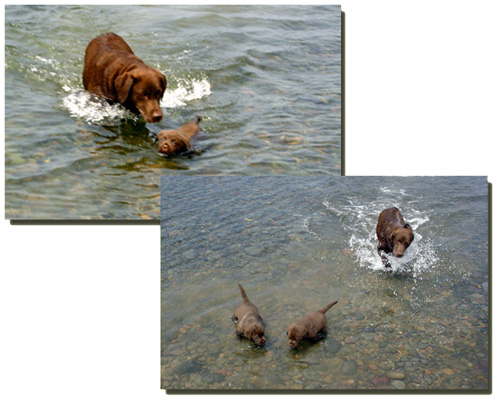
Labrador Retriever
Group: Sporting Group
Height:
Males—22½ to 24½ inches at the withers.
Females—21½ to 23½ inches.
Weight:
Males—65 to 80 lbs.
Females—55 to 70 lbs.
CLICK HERE to View Breeder Listings
Breed Profile
The Labrador Retriever is loyal, devoted, playful, people oriented and hardworking. His expression is alert and intelligent with a kind and friendly temperament. He often works as a guide dog or assistance dog for the disabled; a search-and-rescue dog and a sniffer dog; or he can be found in the field hunting waterfowl. He is patient with children and makes a wonderful companion. Although he may bark protectively, the Labrador is not a good guard dog due to his friendly nature. The Labrador Retriever’s temperament is a hallmark of the breed and the ideal disposition is one of a gentle, adaptable and outgoing nature; eager to please and non-aggressive.
The Lab is a medium-sized, strongly built, well balanced and athletic dog. His coat is short, straight and very dense. The purebred Labrador’s coat comes in only 3 colours: Black, Yellow, or Chocolate. According to the Canadian Kennel Club breed standard: “Yellows range from light cream to fox red with variations in the shadings on ears, under parts, hocks, and down the back. Chocolates range from light sedge to dark chocolate.” Other distinguishing characteristics include an “otter” tail; a clean-cut head and broad skull; and friendly, expressive eyes.
A Word of Caution: In part due to the popularity of the breed, the Labrador Retriever is, unfortunately, at risk of irresponsible breeders attempting to cash in. If you are considering the purchase of a Labrador Retriever puppy, be especially selective in choosing a responsible and reputable breeder. (For more information on selecting a breeder, see the articles on the General Information section.)
A Brief History of the Labrador Retriever
There are many theories as to the origin of the Labrador Retriever. It is believed that the Lab’s ancestors were brought to Newfoundland by explorers, fishermen, and settlers from England and other European nations. One theory suggests that the Labrador descended from the Newfoundland dog. However, there is no evidence that any dogs existed in Newfoundland prior to the arrival of the fishermen or explorers and, in fact, it is thought that the Newfoundland dog itself was brought to the island by fishermen from Europe. It is believed that these dogs adapted to their environment and, by natural selection, evolved into two distinct types: the large heavy-coated dog now known as the Newfoundland dog and the smaller, shorter-coated type called the “black Water Dog”, the “lesser Newfoundland” and later, the “St.John’s dog.” Both types were excellent water dogs, had strong inherent hunting abilities and thick double coats to protect them from the elements.
In the early 1800s, several sportsmen and members of English nobility acquired some of the smaller-type dogs and brought them back to England. For many years, the breed was kept pure. However, when difficulty arose in obtaining fresh breeding stock, the Labs were crossed with other sporting breeds. The Labrador Retriever, as he is known today, was therefore of British origin.
The breed quickly became the sporting dog of choice in Britain and earned respect throughout the world as a war dog, police dog and guide dog for the blind. The breed was officially recognized by The Kennel Club (U.K.) in 1903 and was first registered in Canada in 1905. It was not until 1917 that the first Labrador Retriever was registered by the American Kennel Club.
Today, based on Canadian Kennel Club and American Kennel Club registrations, the Labrador Retriever has been the most popular breed in Canada and the U.S. for the past several years.
Additional Reading:
- The Origin and Purpose of the Labrador Retriever — From the Labrador Retriever Club, Inc. (LRC)
Health Issues
Labrador Retrievers, as with other breeds, are susceptible to some health problems, some of a genetic nature, others viral. The Health Concerns for the Labrador Retriever document includes information on some of the known health concerns found in the breed.
If you are considering the adoption of a Labrador Retriever puppy, or any breed, it is very important to be selective in choosing a responsible and reputable breeder. Ensure that the prospective puppy’s parents have all health clearances. For the Labrador Retriever, this should include x-rays certified by the Ontario Veterinary College (OVC), the Orthopedc Foundations for Animals (OFA), or PennHip to exclude hip dysplasia and elbow dysplasia; eyes should be examined by an opthamologist to ensure that they are clear of hereditary eye disease; and blood tests for PRA by Optigen are strongly recommended. (For more information on selecting a breeder, see the articles on the General Information page.)
Additional Health Resources:
- Canine Inherited Disorders Database – Labrador Retriever
- Canine Health Information Center (CHIC) – Labrador Retriever — Providing a source of health information for owners, breeders, and scientists that will assist in breeding healthy dogs. CHIC is a centralized canine health database jointly sponsored by the AKC/Canine Health Foundation (AKC/CHF) and the Orthopedic Foundation for Animals (OFA).
- Optigen — Established to provide DNA based diagnoses and information about inherited diseases of dogs.
- Health and Nutrition — Growing section of the Canada’s Guide to Dogs website which includes information on several health and nutrition related issues.
- AKC Canine Health Foundation — Working towards developing scientific advances in canine health.
- OFA – Companion Animal Eye Registry (CAER)
- Orthopedic Foundation for Animals (OFA)
- Ontario Veterinary College (OVC)
- University of Pennsylvania Hip Improvement Program (PennHip)
- HealthGene — HealthGene Corporation is the leading provider of veterinary DNA diagnostic services in Canada.
- Labgenvet — Laboratory of Veterinary Genetics is a Canadian diagnostic laboratory that offers a comprehensive service of DNA tests for veterinary genetic diseases.

Grooming Information
- Grooming Your Labrador Retriever
- Grooming — This section of the Canada’s Guide to Dogs website includes tips, articles and information covering all aspects of dog grooming along with a listing of Groomers from across Canada.
Training Resources
- Training — For training information, see this growing section of the Canada’s Guide to Dogs website for tips, articles, as well as listings of training centres across Canada.
Additional Information
- FAQ Labrador Retrievers — A comprehensive questions and answers section found at the Puget Sound Labrador Retriever Association website.
- Conformation Requirements — Working vs. Show Dogs by Dr. B.W. Ziessow
- English or American Labrador?
- You Want A Puppy, But Are You Really Ready? — A must read article for the potential Labrador Retriever owner, from Blue Knight Labradors.
- Is That A Labradoodle? — A must read article regarding “Doodles” and “Poos”. These are not “exotic new breeds”. This is being included in the Labrador Retriever breed section because of what is known as the Labradoodle — the cross of a Poodle and Labrador Retriever. Again, this is not an exotic new breed.
- Labrador Retriever Database
The database includes more than 60,000 Labrador Retriever Dogs and more than 5,000 Kennel names are listed from around the world. - Clubs, Sports & Activities — For information on the many sports and activities you can get involved in with your dog.
- Working Dogs — The Working Dogs section of the Canada’s Guide to Dogs website provides information and listings of organizations that are involved in various dog jobs, such as Guide Dogs, Therapy Dogs, Police Dogs, Protection Dogs, and much more.
Breed Listing
*NOTE 1: CHIC – The Canine Health Information Center “is a database of consolidated health screening results from multiple sources. Co-sponsored by the Orthopedic Foundation for Animals (OFA) and the American Kennel Club (AKC) Canine Health Foundation, CHIC works with parent clubs to identify health screening protocols appropriate for individual breeds. Dogs tested in accordance with the parent club established requirements, that have their results registered and made available in the public domain are issued CHIC numbers.” To learn more, visit: www.caninehealthinfo.org
*NOTE 2: The Fédération Cynologique International (FCI) is the World Canine Organization, which includes 91 members and contract partners (one member per country) that each issue their own pedigrees and train their own judges. The FCI recognizes 344 breeds, with each being the “property” of a specific country. The “owner” countries write the standards of these breeds in co-operation with the Standards and Scientific Commissions of the FCI, and the translation and updating are carried out by the FCI. The FCI is not a breed registry nor does it issue pedigrees.
Quick Links
Get In Touch
- Email: canadasguidetodogs@gmail.com
- Email: info@canadasguidetodogs.com
- Visit us on Facebook: www.facebook.com/CanadasGuideToDogs
— CanadasGuideToDogs.com is an Amazon Associate as well as a participant in various affiliate programs, as such fees are earned from qualifying purchases.



